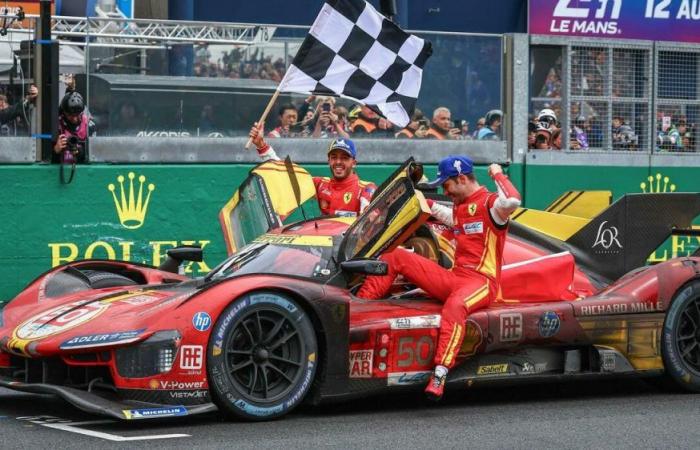Made in Italy wins Le Mans: it’s still Ferrari. The key, needless to say, is Motor Valley. Absolute excellence when it comes to technology and engines, tradition and passion. After an edition as spectacular as ever, with around twenty cars at the start which, at least on paper, had the right pedigree to aim for victory, in the last half hour there were at least four automotive brands still dreaming of triumph . Global and prestigious, all rich in history and coming from the three geographical areas that count in the world map of the new millennium: Europe, America and Asia. Yet, the 24 Hours has always been a “home” fort, where the builders of the old continent have never left drafts for those coming from far away to squeeze in.
With only two exceptions: Ford, in the sixties, with a historic consecutive poker, and Toyota, at the turn of the twenties of the new millennium, with an equally peremptory five in a row. The rest is a parade of exclusive continental brands. Just to name a few in over a century of history: Bentley, Alfa Romeo, Bugatti, Ferrari, Jaguar, Mercedes, Aston Martin, Porsche, Renault, Alpine, Peugeot, BMW, Audi. Yesterday, in the 92nd edition of the four-wheel marathon, the master stroke was scored by Ferrari which, with diabolical skill, took home its 11th Trophy. Especially the second consecutive one after last year which marked the official return to the fight for absolute victory after a drought of exactly half a century. A big party. An apotheosis.
The race was spectacular and a bit original, the synthesis of how modern motorsport has changed car racing on the sacrosanct altar of safety. The battle was battered by rain that came and went, turning the asphalt into a chameleon-like swamp that at times had the energy of a mountain stream. When the cars crash, it is necessary to intervene by eliminating the risks and then restore the barriers to start driving again. As a result, the competition was held for a quarter under the safety car regime (there wasn’t one in the heroic times…) and the cars completed “just” 311 laps.
Suffice it to say that, only in 2010, the diesel-powered Audi won of laps he recorded 397, a third more than this year, for a total distance of 5,410.71 kilometers at the fantastic average hourly of 225.446 km/h. To find a similar pace you have to go back more than half a century when, in 1971, Helmut Marko (yes, Red Bull’s super talent scout manager) won over the Dutchman Gijs van Lennep (at the time, to make the more heroic things, there were only two of them running) at an average of 222.304 km/h, traveling for 5,335.313 km. How is it possible that over fifty years ago the racing cars were faster than the current ones? Simple, without chicanes, the Le Mans track was a large oval of over 13 km which had the long Hunaudières straight of over 6 km to cover in one go. Full.
The bullfight was exciting, always very uncertain. In the end Maranello triumphed, but never took a walk. Also in the pits is Maranello’s extra man, the “genius-inventor” Benedetto Vigna who, since taking over the reins of the Cavallino, is making it run faster than ever. He doesn’t miss out on key moments, but always leaves the scene to his boys. He was also there last year at La Sarthe, behind the scenes and not on stage. The battle took place without taking a breather, lasting 86,400 seconds like every day. Several rivals took turns taking turns, each taking advantage of the changing situation they liked best.
The Reds, among which there was also a third yellow 499P but identical, they were the most on the ball when the track was dry, when the potential of an innovative and ambitious project could be fully exploited. Fast on the long straights, agile in the chicanes, very stable in the Porsche turns to be taken with support. More difficult when the situation changed and the tire temperature had to be managed. She won the number 50, the one driven by Fuoco-Molina-Nielsen, but last year’s triumphant number 51 finished just 36 seconds behind her sister after 24 hours of fire. Between the two, Toyota took the podium after having dominated for five years before Ferrari’s return.
The last laps were heart-pounding. Nielsen, who was leading, was called back to the pits to close a door that was left open. An incredible misfortune: making an extra stop on the razor’s edge meant throwing away dreams of glory. Ferrari was trying everything: filling up and trying, it’s make or break. Of course, a little help was needed to get through the remaining hour with a full tank of petrol. And there was help: several yellow flags throttled the pace and there was even rain to keep the engines quiet. So Nielsen made it by just 14 seconds. The Italian presence was excellent: the Lamborghinis finished tenth and thirteenth, on the same lap as the Peugeots, the Isotta Fraschini, in its first 24 Hours, finished behind the second racing car from Sant’Agata.
© ALL RIGHTS RESERVED
Read the full article at
The messenger




